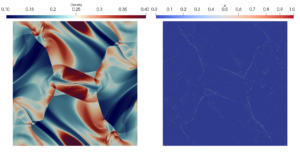Meiotic recombination is an essential mechanism during sexual reproduction and includes the exchange of chromosome segments between homologous chromosomes. New allelic combinations are transmitted to the new generation, introducing novel genetic variation in the offspring genomes. With the improvement of high-throughput whole-genome sequencing technologies, large numbers of recombinant individuals can now be sequenced with low sequencing depth at low costs, necessitating computational methods for reconstructing their haplotypes. The main challenge is the uncertainty in haplotype calling that arises from the low information content of a single genomic position. Straightforward sliding window-based approaches are difficult to tune and fail to place recombination breakpoints precisely. Hidden Markov Model-based approaches, on the other hand, tend to over-segment the genome. Here, we present RTIGER, an HMM-based model that exploits in a mathematically precise way the fact that true chromosome segments typically have a certain minimum length. We further separate the task of identifying the correct haplotype sequence from the accurate placement of haplotype borders, thereby maximizing the accuracy of border positions. By comparing segmentations based on simulated data with known underlying haplotypes, we highlight the reasons for RTIGER outperforming traditional segmentation approaches. We then analyze the meiotic recombination pattern of segregants of two Arabidopsis (Arabidopsis thaliana) accessions and a previously described hyper-recombining mutant. RTIGER is available as an R-package with an efficient Julia implementation of the core algorithm.
Plants Physiology: https://doi.org/10.1093/plphys/kiad191
